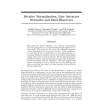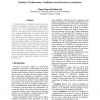155 search results - page 16 / 31 » Formal Theory of Noisy Sensor Network Localization |
NIPS
1998
13 years 9 months ago
1998
Gain control by divisive inhibition, a.k.a. divisive normalization, has been proposed to be a general mechanism throughout the visual cortex. We explore in this study the statisti...
IEEEMSP
2002
IEEE
14 years 15 days ago
2002
IEEE
Abstract— We consider the problem of reachback communication in wireless sensor networks: multiple sensors are deployed on a field, and they collect local measurements of some r...
MOBIHOC
2009
ACM
14 years 8 months ago
2009
ACM
Location-free boundary recognition is crucial and critical for many fundamental network functionalities in wireless ad hoc and sensor networks. Previous designs, often coarse-grai...
CVPR
2000
IEEE
14 years 9 months ago
2000
IEEE
Design and development of novel human-computer interfaces poses a challenging problem: actions and intentions of users have to be inferred from sequences of noisy and ambiguous mu...
TPDS
2010
13 years 6 months ago
2010
The proliferation of wireless and mobile devices has fostered the demand of context aware applications. Location is one of the most significant contexts. Multilateration, as a bas...



